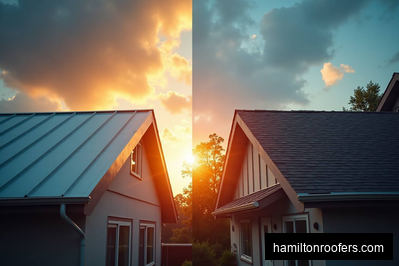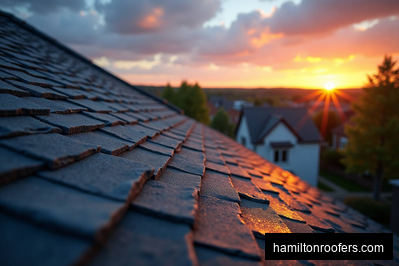Introduction
Choosing the right roofing material for your home is a crucial decision. It influences not only the aesthetics of your home but also its durability, energy efficiency, and maintenance requirements. Today, we delve into an in-depth comparison of two of the most popular roofing choices: metal and asphalt shingles.
Both these materials have their unique characteristics, advantages, and disadvantages. Therefore, understanding them can help homeowners make an informed decision. Let's uncover the details of metal and asphalt shingles.
As we delve deeper into the world of roofing materials, it becomes evident that the initial selection process is just the beginning of a homeowner's journey towards a durable and visually appealing roof. An introduction to roofing materials sets the stage for exploring various options such as asphalt shingles, metal roofing, or clay tiles. Each material boasts unique characteristics that cater to different needs and preferences, offering homeowners a plethora of choices to suit their specific requirements.
Furthermore, understanding the lifespan, maintenance requirements, and environmental impact of different roofing materials is essential for making an informed decision. The introduction to roofing materials serves as a gateway to a more in-depth analysis of the pros and cons of each option, empowering homeowners to make a well-informed choice that aligns with their budget and aesthetic preferences. By laying a strong foundation in the introductory phase, homeowners can navigate the roofing material selection process with confidence and clarity.
Overview of Metal and Asphalt Shingles
Metal roofs are a popular choice for their longevity and durability. They are constructed from various metal types, including aluminum, copper, zinc, and steel. Metal roofs are known for their resistance to harsh weather conditions, fire, and pests. They reflect sunlight, thereby reducing cooling costs during summer.
On the other hand, asphalt shingles are a common roofing material due to their cost-effectiveness and easy installation process. Made from fiberglass sandwiched between asphalt and ceramic granules, they offer a classic, textured appearance suited to various architectural styles. Asphalt shingles are available in various colors and designs, giving homeowners a wide range of choices.
When comparing metal and asphalt shingles for roofing, it's essential to consider not just their durability but also their aesthetic appeal. Metal shingles, often made from materials like steel or aluminum, offer a modern and sleek look that can enhance the overall appearance of a home. On the other hand, asphalt shingles, which come in a variety of colors and styles, provide a more traditional and versatile option that can complement different architectural designs.
Additionally, the installation process for metal and asphalt shingles varies significantly. Metal shingles usually require specialized installation techniques to ensure proper sealing and weatherproofing, making them a bit more complex to install compared to asphalt shingles. Understanding these distinctions can help homeowners make informed decisions when selecting the right roofing material for their needs.
Cost Comparison
Cost is a significant factor when choosing roofing materials. Asphalt shingles are less expensive upfront, with the average cost per square foot ranging between $1.50 and $5.50. However, their lifespan is shorter, requiring replacement every 15-30 years, which can add to the long-term cost.
Conversely, metal roofs are more expensive initially, with costs per square foot ranging from $5 to $14. While the upfront cost may be higher, their longevity (40-70 years) makes them a cost-effective solution in the long run. Furthermore, their energy efficiency can lead to savings on energy bills.
When diving deeper into the cost comparison of roofing materials, it's crucial to consider the long-term financial implications. While asphalt shingles may have a lower upfront cost, they typically have a shorter lifespan compared to metal or tile roofing options. This means that homeowners may end up spending more in the long run on repairs and replacements. On the other hand, investing in higher-quality materials initially, such as metal or tile, can result in lower maintenance costs and a longer-lasting roof. Additionally, these premium materials often come with warranties that provide added protection and peace of mind for homeowners. Therefore, when evaluating cost, it's essential to look beyond the initial price tag and consider the overall value and durability of the roofing material.
Durability and Maintenance
Durability is another crucial factor to consider. Metal roofs are highly durable, with a lifespan of 40-70 years. They resist harsh weather conditions, including heavy snow, hail, and high winds. Moreover, they are fire-resistant and impervious to pests. However, they can be prone to denting from large hail or falling branches.
Asphalt shingles, on the other hand, have a shorter lifespan of about 15-30 years. They are less resistant to harsh weather conditions and may require more frequent repairs or replacements. Additionally, they can be susceptible to algae and moss growth, particularly in damp climates. However, they are easier and cheaper to repair than metal roofs.
When it comes to maintaining metal roofs for longevity, regular inspections and maintenance routines are key. Inspecting the roof for any signs of wear and tear, such as loose screws or damaged panels, can prevent minor issues from escalating into larger problems. Additionally, cleaning the roof periodically to remove debris and prevent rust can significantly extend its lifespan. Some metal roof manufacturers also recommend applying protective coatings every few years to enhance durability and weather resistance.
Moreover, proactive maintenance not only ensures the durability of the roof but also contributes to its aesthetic appeal. By addressing maintenance tasks promptly, homeowners can preserve the roof's appearance and structural integrity, ultimately saving on repair costs in the long run. Investing time and resources in regular maintenance can pay off by prolonging the life of the metal roof and maintaining its beauty for years to come.
Energy Efficiency and Environmental Impact
Metal roofs are more energy-efficient than asphalt shingles. They reflect solar radiant heat, reducing cooling costs by up to 25%. Moreover, they are made from up to 95% recycled content and are 100% recyclable at the end of their life, making them an eco-friendly choice.
Asphalt shingles absorb more heat, which may increase cooling costs. They are less eco-friendly due to their shorter lifespan and the fact that old shingles often end up in landfills. However, some recycling programs do exist for asphalt shingles, turning them into road pavement or other products.
In addition to metal roofs, another key aspect of enhancing energy efficiency and reducing environmental impact in buildings is through the implementation of smart lighting systems. These systems utilize sensors and advanced controls to adjust lighting levels based on natural light availability and occupancy, significantly cutting down on energy consumption. For instance, motion sensors can automatically turn off lights in unoccupied rooms, saving electricity and lowering carbon emissions. Furthermore, LED light fixtures are not only energy-efficient but also have a longer lifespan, reducing the frequency of replacements and minimizing waste. By integrating these innovative lighting solutions, buildings can achieve substantial energy savings while contributing to a more sustainable environment.
Aesthetics and Home Value
Aesthetics is a subjective aspect, and what appeals to one homeowner may not appeal to another. Metal roofs offer a sleek, modern look and come in a variety of colors and styles. They can also mimic other materials, like wood shakes or tile, providing versatility in design.
Asphalt shingles offer a traditional, textured appearance and come in a wide range of colors and styles. They are often favored for their ability to match various architectural styles. Moreover, both materials can increase home value, with metal roofs potentially offering a higher return on investment due to their longevity and energy efficiency.
Aesthetics play a significant role in determining a home's value, as they can greatly influence a buyer's perception of a property's worth. For example, a well-maintained garden with colorful flowers and neatly trimmed hedges can enhance curb appeal, making a home more attractive to potential buyers and ultimately boosting its market value. Similarly, upgrading outdated fixtures with modern and stylish alternatives can make a home feel more contemporary and appealing, thereby increasing its desirability and resale potential. It's crucial for homeowners to consider the impact of aesthetics on their property's value and make strategic improvements that align with current design trends and buyer preferences.
Conclusion
In conclusion, both metal and asphalt shingles have their strengths and weaknesses. The choice between these two materials should be based on several factors, including budget, climate, aesthetics, and long-term plans for the home.
For homeowners looking for longevity, durability, and energy efficiency, a metal roof could be an excellent investment, despite the higher upfront cost. On the other hand, those seeking a cost-effective, easy-to-install option, with a traditional aesthetic, may prefer asphalt shingles. Ultimately, it's about finding the balance between cost, durability, and aesthetics that fits your needs best.
In conclusion, while weighing the pros and cons of metal and asphalt shingles is crucial, it's equally important to consider the climate and location of the property. For instance, in areas prone to extreme weather conditions like hurricanes or heavy snowfall, metal shingles might offer better durability and resistance compared to asphalt. Additionally, the aesthetic appeal and architectural style of the building should also play a significant role in the decision-making process.
Moreover, budget constraints can heavily influence the choice between metal and asphalt shingles. Although metal shingles are generally more expensive upfront, they often require less maintenance and have a longer lifespan, making them a cost-effective option in the long run. On the other hand, asphalt shingles provide a more affordable alternative for homeowners looking to achieve a traditional look without breaking the bank.









